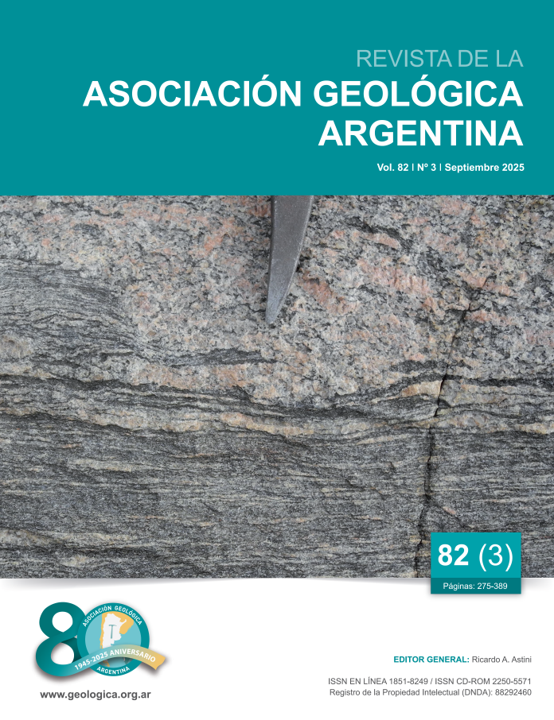Decoding Cambrian migmatites through their melting and deformation textures: the case of the La Totorilla diatexites, San Carlos Massif, Sierras Pampeanas of Córdoba, Argentina
Contenido principal del artículo
Resumen
The La Totorilla anatectic body is located within the San Carlos Migmatitic Massif, part of the Central Granulitic Belt , a regional thermal axis of the Sierras Pampeanas in Córdoba, Argentina. The body has an elliptical shape (~ 3 × 0.5 km) and consists of foliated,
potassium feldspar and cordierite porphyroblastic diatexites, showing clear evidence of melting and deformation. It is enclosed by the Pichanas migmatites exhibiting a characteristic schollen structure. Both lithologies contain schlieren and lenticular xenoliths derived from the Tuclame Banded Schists and biotite gneisses. Tourmaline-bearing granitic pegmatite veins cut across these units, locally evolving from boudins into folds. The evolution of the La Totorilla diatexites is divided into three stages: (1) a prograde phase marked by staurolite–biotite assemblages (~ 600 °C); (2) a metamorphic peak at ~ 788 °C and medium pressure (≤ 6 kbar), characterized by cordierite, K-feldspar, and melt generation through biotite dehydration; and (3) a retrograde stage involving progressive deformation, cooling, and hydration. The penetrative S2 foliation (N 300°) dominates the area and formed under pure-shear flattening. Structurally, the La Totorilla body is boudinaged within the Pichanas migmatites, reflecting a pronounced lithological and rheological contrast. U–Pb zircon rims ages indicate that La Totorilla formed at 532.1 ± 1.7 Ma during the Pampean orogeny, at middle-crustal levels (≤ 22 km depth), along the southwestern margin of Gondwana. This body constitutes a key example of an anatectic rock recording the interplay of metamorphism, deformation, and partial melting during the early Cambrian evolution of the Sierras Pampeanas.
Detalles del artículo

Esta obra está bajo una licencia internacional Creative Commons Atribución-NoComercial 4.0.
Nota de copyright
Los autores conservan los derechos de autor y garantizan a la revista el derecho de ser la primera publicación del trabajo licenciado según una licencia de atribución Creative Commons que permite a otros compartir el trabajo con el reconocimiento de la autoría y de la publicación en la que se publicó por primera vez.
Declaración de privacidad
Los nombres y direcciones de correo electrónico introducidos en esta revista se usarán exclusivamente para los fines declarados por esta revista y no estarán disponibles para ningún otro propósito u otra persona.

